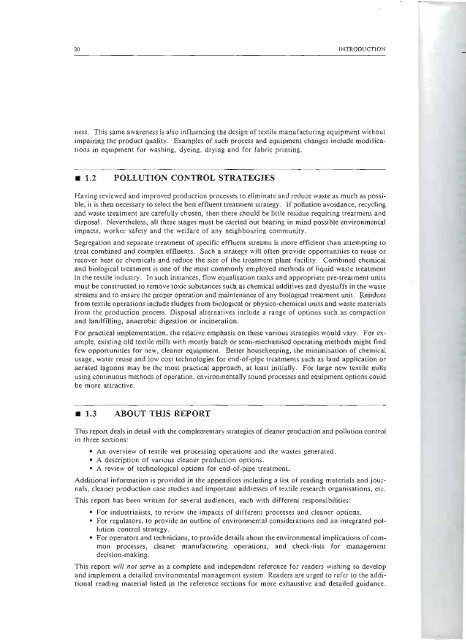Contributor, The Textile Industry and the Environment, UNEP
Contributor, The Textile Industry and the Environment, UNEP
Contributor, The Textile Industry and the Environment, UNEP
Create successful ePaper yourself
Turn your PDF publications into a flip-book with our unique Google optimized e-Paper software.
20 INTRODUCTION<br />
ness. This same awareness is also influencing <strong>the</strong> design of textile manufacturing equipment without<br />
impairing thc product quality. Examples of such process <strong>and</strong> equipment changes include modifications<br />
in equipment for washing, dyeing, drying <strong>and</strong> for fabric printing.<br />
• 1.2 POLLUTION CONTROL STRATEGIES<br />
Having reviewed <strong>and</strong> improved production processes to eliminate <strong>and</strong> reduce waste as much as possibIe,<br />
it is <strong>the</strong>n necessary to select <strong>the</strong> best effluent treatment strategy. If pollution avoidanee, recycling<br />
<strong>and</strong> waste treatment are carefully chosen, <strong>the</strong>n <strong>the</strong>re should be little residue requiring treatment <strong>and</strong><br />
disposal. Never<strong>the</strong>less, all <strong>the</strong>se stages must be carried out bearing in mind possible environmental<br />
impacts, worker safety <strong>and</strong> <strong>the</strong> welfare of any neighbouring community.<br />
Segregation <strong>and</strong> separate treatment of specific effluent streams is more efficient than attempting to<br />
treat combined <strong>and</strong> complex effluents. Such a strategy will often provide opportunities to reuse or<br />
recover heat or chemicals <strong>and</strong> reduce <strong>the</strong> size of <strong>the</strong> treatment plant facility. Combined chemical<br />
<strong>and</strong> biological treatment is one of <strong>the</strong> most commonly employed methods of liquid waste treatment<br />
in <strong>the</strong> textile industry. In such instances, flow equalisation tanks <strong>and</strong> appropriate pre-treatment units<br />
must be constructed to remove toxic substances such as chemical additives <strong>and</strong> dyestuffs in <strong>the</strong> waste<br />
streams <strong>and</strong> to ensure <strong>the</strong> proper operation <strong>and</strong> maintenance of any biologicaJ treatment unit. Residues<br />
from textile operations include sludges from biological or physico-chemical units <strong>and</strong> waste materials<br />
from <strong>the</strong> production process. Disposal alternatives include a range of options such as compaction<br />
<strong>and</strong> l<strong>and</strong>fi1ling, anaerobic digestion or incineration.<br />
For practical implementation, <strong>the</strong> relative emphasis on <strong>the</strong>se various strategies would vary. For example,<br />
existing old textile mills with mostly batch Or semi-mechanised operating methods might find<br />
few opportunities for new, cleaner equipment. Better housekeeping, <strong>the</strong> minimisation of chemical<br />
usage, water reuse <strong>and</strong> low cost technologies for end-of-pipe treatments such as l<strong>and</strong> application or<br />
aerated lagoons may be <strong>the</strong> most practical approach, at least initially. For large new textile mills<br />
using continuous methods of operation, environmentally sound processes <strong>and</strong> equipment options could<br />
be more attractive.<br />
• 1.3 ABOUT THIS REPORT<br />
This report deals in detail with <strong>the</strong> complementary strategies of cleaner production <strong>and</strong> pollution control<br />
in three sections:<br />
• An overview of textile wet processing operations <strong>and</strong> <strong>the</strong> wastes generated.<br />
• A description of various cleaner production options.<br />
• A review of technological options for end-of-pipe treatment.<br />
Additional information is provided in <strong>the</strong> appendices including a list of reading materials <strong>and</strong> journals,<br />
cleaner production case studies <strong>and</strong> important addresses of textile research organisations, etc.<br />
This report has been wri tten [or several audiences, each with different responsi bilities:<br />
• For industrialists, to review <strong>the</strong> impacts of different processes <strong>and</strong> cleaner options.<br />
• For regulators, to provide an outline of environmental considerations <strong>and</strong> an integrated pollution<br />
control strategy.<br />
• For operators <strong>and</strong> technicians, to provide details about <strong>the</strong> environmental implications of common<br />
processes, cleaner manufacturing operations, <strong>and</strong> check-lists for management<br />
decision-making.<br />
This report will not serve as a complete <strong>and</strong> independent reference for readers wishing to develop<br />
<strong>and</strong> implement a detailed environmental management system. Readers are urged to refer to <strong>the</strong> additional<br />
reading material listed in <strong>the</strong> reference sections for more exhaustive <strong>and</strong> detailed guidance.

















